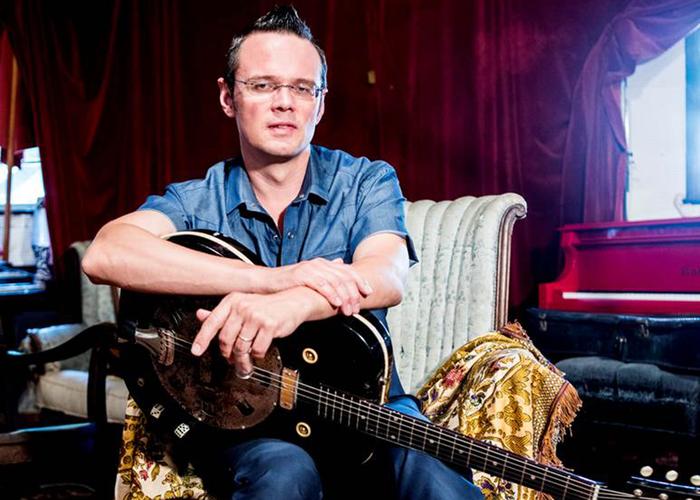
Genre:Rock
On Blues & Ballads (A Folksinger’s Songbook) Volumes I & II, Luther Dickinson finds his way forward by retracing his steps. This ambitious double album collects twenty-one tunes from throughout his life and career—a handful of new songs, songs he wrote with his rock & roll band the North Mississippi Allstars, songs he learned friends and family, songs passed down to him by his heroes and mentors, songs that have lived in the American subconscious for decades now—and pares them down to their irreducible elements. Voice, guitar, drums. Here and there some blues fife or Beale Street piano.The performances on the record itself are some of his most excitable and energetic, with the bounce and rumble of early blues and rock; the arrangements transcribed in the illustrated songbook (which accompanies the vinyl edition of the album) reveal the intricate and imaginative rhythms and melodies that underpin all of Luther’s compositions. “The idea,” he says, “was to re-record everything very stripped down—very acoustic and honest and folky—to accompany the songbook.” As the subtitle suggests, this is only the beginning of what promises to be a multi-volume undertaking.It started, as so many good things do, with Mavis Staples.The two have been friends and occasional musical partners for twenty years: She has sung with his rock-and-roll band the North Mississippi Allstars, and he accompanied her on the soundtrack to “Take Me to the River,” the 2014 documentary about soul music in the South. When Mavis mentioned that she wanted to record the Allstars tune “Hear the Hills,” Luther knew he had to make it happen. On the day of the session, however, Mavis changed her mind and asked to record another song, “Ain’t No Grave,” from the Allstars’ 2011 album Keys to the Kingdom.It’s a song that means the world to Luther. He wrote it shortly after the death of his father, the producer/singer/songwriter/all-around badass Jim Dickinson. Most people know him as a session musician who played on hits by the Stones and Dylan or as a producer who helmed seminal albums by Big Star and the Replacements. He taught Luther everything he knows: how to play guitar, how to lead a band, how to keep a songwriter’s notebook.For Mavis, “Ain’t No Grave” is the kind of song her own father—the great Pops Staples— might have taught her and her sisters back in the 1950s and ‘60s, when the Staple Singers were the biggest name in gospel. Arranged, performed, and recorded on the fly, their version of the tune is haunting. The tempo is slow but determined, as though midway through a long, arduous journey. Shardé Thomas taps out a sympathetic rhythm on her drums while Luther lays down a wiry blues riff and sings about living up to his father’s example: “When the day comes, death comes back my way,” they sing together, “I would hope to be as brave as he was on Judgment Day.”Mavis sings behind him, her voice trailing his, her presence a reassuring hand on Luther’s shoulder. Fatigue colors their voices, evoking the inescapable gravity of death: We are all pulled toward the grave, but it’s what we do along the way that matters. At the heart of the song is a kernel of hard-won hope, as though simply making music is consolation enough.That memorable session sent Luther down the road toward Blues & Ballads, which he describes as a community project: “This is the most casual record I ever made. I’d record one or two songs at a time, very effortlessly and unstrategically. Then I started recording songs with different groups of friends, wherever I happened to be.” Fortunately, he happened to be in some of the best and most historic rooms in the world, including Sun Studio and Willie Mitchell’s Royal Studios in Memphis. Equally fortunately, he has some incredibly talented friends: Jason Isbell, J.J. Grey, Alvin Youngblood Hart, Jimbo Mathus, Lillie Mae Rasche, and Charles Hodges, a keyboard player of the legendary Hi Records rhythm section that backed Al Green. And, of course, Luther’s longtime backing band: Amy LaVere on bass and Shardé Thomas on drums, fife, and vocals.Blues & Ballads has a retrospective flavor, but it’s not greatest hits. Rather, it’s a means of translating these songs to a new moment, of letting them breathe and take new shapes. In that regard, it’s fitting that the vinyl edition includes that songbook. “I love all sorts,” says Luther, an avid collector of “hymnals, children’s songs, country music, whatever. And I’ve always wanted to have my own.” When he was growing up in rural Mississippi, these songbooks formed the bedrock of his musical education. “My grandmother was the church pianist, and I remember looking at the hymnals and trying to figure out the music. I would read the words and listen to the people singing along. Growing up pre-Internet, I would go to the library and memorize every music book in the Hernando Public Library.”Around this same time, Luther learned to keep copious notebooks full of stray thoughts, fragments